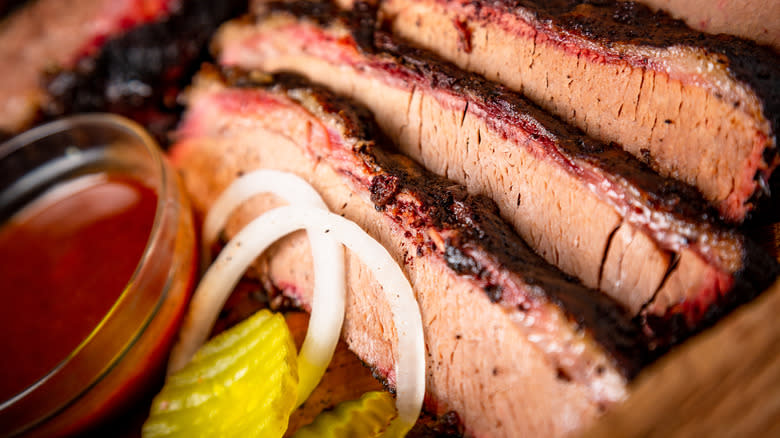Here's Why Texas Roadhouse Is Once Again Raising Its Prices

If you've eaten red meat in the last year, you've seen prices rise everywhere, the grocery store and restaurant menus alike. Texas Roadhouse is no exception. For the second time this year, the casual dining steakhouse chain has raised its prices. The news comes from an earnings call on Thursday, when Jerry Morgan — the CEO — announced another 2.7% increase at the beginning of the quarter, making a 5.5% total increase in menu prices. Morgan cited beef prices and wage inflation as the primary cause for the hikes, with a preemptive eye toward "the impact of upcoming state mandated wage increases."
The Head of Investor Relations, Michael Bailen, also announced that the company would be leaning harder into to-go business. This move is intended to drive better margins, in no small part from limiting the amount of server staffing it would have to pay for. As it's raising its consumer prices, it's worth noting that Texas Roadhouse is opening 25-30 new locations and brought in 13% more revenue this year than last as of September. Although there was an industry expectation of a drop in customer traffic for Texas Roadhouse and similar chains, the call proved that Texas Roadhouse actually saw customer traffic increase this year.
Read more: The 13 Best Steaks For Grilling
What's The Real Deal With Rising Costs?

As far as the cost of server labor goes, at least remember that those are tipped employees. Federally, the base minimum wage for a tipped employee is $2.13. Only eight states — New York, California, Colorado, Minnesota, Oregon, Nevada, Alaska, and Washington — have minimum wages over $10 for tipped employees. Thirty states don't even require restaurants to pay their employees over $5 an hour. Consumers are already carrying the brunt of server wages through tips. Back-of-house staff wages for Texas Roadhouse average just $10 across the country, according to Indeed.
During the earnings call, Chris Monroe, the Chief Financial Officer, pointed out that beef, not wage inflation, was still the primary driver of this year's inflated costs. There's been a shortage of beef since 2022 that's not looking to get better anytime soon. Long droughts in beef states like Kansas, Texas, Nebraska, and Oklahoma lead to smaller herds and less available beef. Between climate pressures, the rising costs of cattle feed from global events like Russia's invasion of Ukraine, and supply chain issues dating back to the start of the pandemic, it's unlikely that beef costs will come down anytime soon. And although Texas Roadhouse executives told investors on the call that purchasing teams have done a "great job" locking in pricing with meatpackers (who have seen soaring profits while consumers face "inflation increases") through early 2024, customers can likely count on another price hike after those contracts are renegotiated.
Read the original article on Daily Meal.

